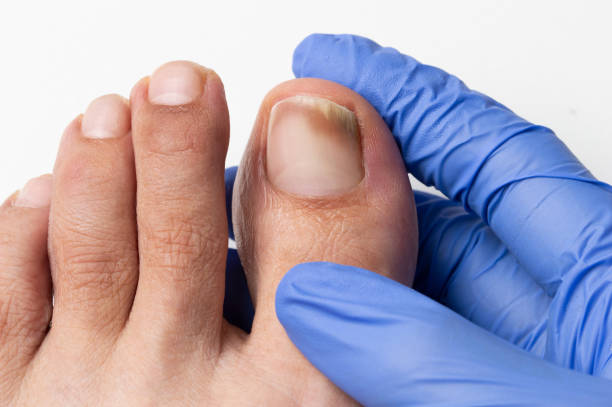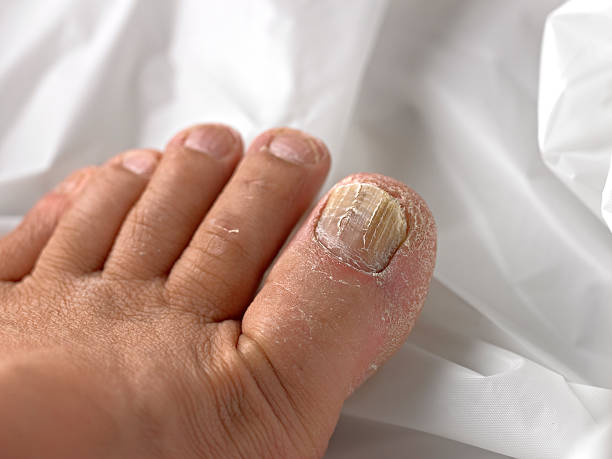Many people use non-prescription antifungal polish and creams to treat nail fungus. Unfortunately, these treatments have a low cure rate.
Antifungal tablets, such as terbinafine and itraconazole, can be effective. Taking these drugs for several months usually cures the infection. These medications can have serious side effects, so doctors monitor them carefully with blood tests.

Genesis Plus Laser Treatment
Genesis Plus Laser Treatment is a new laser perfected for safely and effectively treating onychomycosis (toenail nail fungus). This procedure eliminates the need for oral medications which have a low success rate and cause unpleasant side effects. During the procedure, near infrared laser light is passed over and through your nail and the surrounding skin. This process heats the pigmentation of the fungus and kills it. The laser does not damage the nails or surrounding skin and is completely painless. It may require multiple treatment sessions, but each session is quick and comfortable.
During the treatment, podiatrist in Albany, WA will pass the laser beam over each affected toenail and surrounding skin. The nail and skin will feel slightly warm, but not uncomfortable. This procedure is safe and effective, and results are typically seen within 6 months.
While nail trimming, topical medications, and home remedies such as tea tree oil, bleach, or iodine can be useful for keeping your toenails healthy, they do not treat the fungus that causes them to thicken, discolor, and crumble. These treatments also require regular maintenance, and they do not cure the fungus that is causing your nails to become infected in the first place. To truly treat the fungus, you will need to use the GenesisPlus laser treatment in conjunction with other treatments.
Oral Medication
Over-the-counter antifungal nail creams can sometimes make the infection go away, but they do not fully treat the underlying problem. The toenail produces a limitless supply of keratin that the fungi can consume, so they cannot be defeated with over-the-counter treatments. Moreover, the top of the toenail is protected by a thick layer of skin, and traditional medications can’t reach the infection underneath.
To fight fungal nails, we need to penetrate the nail itself and attack it at the source. There are several ways to do this, and some have been successful. However, all have disadvantages: they require lengthy treatment, may cause side effects, and can be expensive for many patients.
Fungal nail treatment Albany is a great option for treating severe nail fungus. Studies have shown that terbinafine, and to a lesser degree itraconazole, are more effective than placebo for both making the nail look normal (clinical cure) and eliminating the infection at the microscopic level (mycological cure).
These drugs are taken orally, typically once a day, for 12 weeks. They can have serious side effects, including rashes and liver damage, and should not be used by those with a weakened immune system or chronic diseases such as diabetes. A urea cream that thins the nail can also be helpful, and this is often used in combination with tablet treatment.

Topical Medication
Infected nails may be treated with a special nail polish or cream that contains an antifungal agent. The main ingredient in this type of nail solution is tavaborole. It was developed by scientists in 2014. It is applied daily to the affected nail(s). Various studies have shown that it has a complete cure rate of 17.8%. Another option is ciclopirox, which is also a topical treatment. It was approved by the FDA around the same time. It is rubbed into the nail and surrounding skin. Typically, you will need to apply the solution for about a year to get the best results.
Your doctor can also prescribe oral antifungal medications, such as terbinafine (Lamisil), itraconazole (Sporanox), or fluconazole (Diflucan). These drugs are taken daily for several months and can have serious side effects. They can also interfere with other prescription medications. Your doctor may also need to perform blood tests to check your liver function while you are taking these medications.
Even when you successfully treat your fungal nail infection, the fungus can return. This is especially true if you have other conditions, such as diabetes, that make it harder for your body to fight infections. To prevent nail fungus from returning, you should wash your hands frequently, wear shoes that let your feet breathe, and avoid walking barefoot in public areas. You should also wear gloves and sanitize your nail tools regularly.
Nail Removal
Fungal nail infections can be painful and unsightly. They may also cause the affected nail to change color or shape, become thicker, and detach from the nail bed. It is important to treat these infections early so they do not spread.
Nonprescription antifungal nail creams and ointments such as terbinafine (Lamisil) can help reduce infection and keep it from returning. These products work better if your nails are trimmed and thinned, as this will allow the medication to reach deeper layers of the nail. These treatments can be used in combination with oral antifungal medications.
The most effective treatment for fungus of the nails is an antifungal pill such as itraconazole (Sporanox). These medicines are taken orally and cure fingernail and toenail fungal infections more quickly than medicine applied to the nail. However, they do carry some side effects, and it can take up to a year for healthy nails to grow in place of the infected ones.
Nail fungus can also be prevented by keeping your nails clean and dry. Trim your nails regularly with quality nail clippers, and avoid cutting them too short or wearing tight shoes that put pressure on your toes. Instead, opt for shoes that fit well, and try to find those with square or rounded toe boxes, as these will allow your nails to breathe more easily.